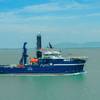As it becomes abundantly clear that a major injection of dollars is not imminent for the U.S. Naval shipbuilding sector, industry leaders met last week to mull ideas on getting more for less. Several hundred people gathered at a recent Plenary Session of the American Society of Naval Engineers (ASNE) to hear shipbuilding industry executives and Navy brass discuss how to produce more ships for the same dollar. Both agreed they must work together to achieve this goal.
"We are not making it in terms of a 300-ship Navy," said Vice Admiral Pete Nanos, Commander, Naval Sea Systems Command. "We are not going to make it unless some things change."
He explained that without an infusion of cash or the dramatic implementation of new technology and business processes, the U.S. Navy is in danger of falling below 300 ships, the minimum number it needs to fulfill its missions.
"If we are driven below a 300-ship Navy, we are not going to be able to provide the service this country has come to expect," Nanos said.
The U.S. Navy has a goal of building 8-12 new ships to its fleet each year in order to maintain its 300-ship fleet. In recent years, the Navy has not funded new ships at this rate because of budget cuts.
"The bottom line is we don't get enough money," said Paul Schneider, who is the Principal Deputy Assistant Secretary of the Navy for Research Development and Acquisition and was the keynote speaker for the session.
Schneider described the last decade as a time of unprecedented change and remarked on the compressed cycle time of technology. This is a major concern for the Navy since the evolution of computers occurs every 18-24 months and aircraft carriers must last 50 years. Schneider said the Navy needs to work hard to insert technology as it is developed while maintaining affordability of ship construction. He encouraged the Navy to examine how the aviation community does business, producing thousands of aircraft for the U.S. and it's allies with 80 percent commonality in the planes being made.
Sponsored Content
Chris-Marine’s solutions help to prolong engine lifetime

Subscribe for
Maritime Reporter E-News
Maritime Reporter E-News is the maritime industry's largest circulation and most authoritative ENews Service, delivered to your Email five times per week










